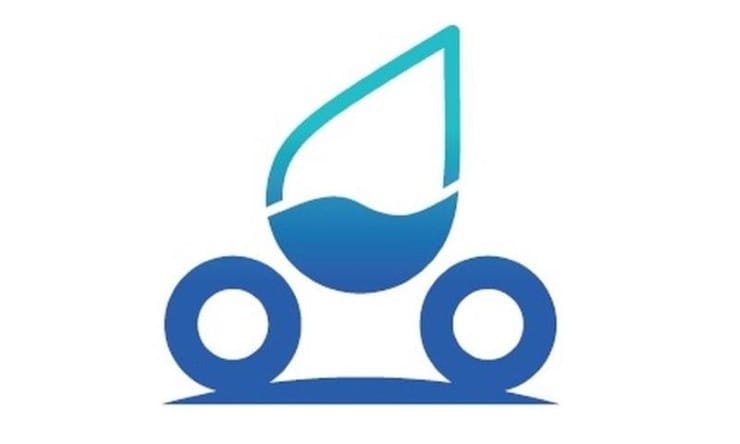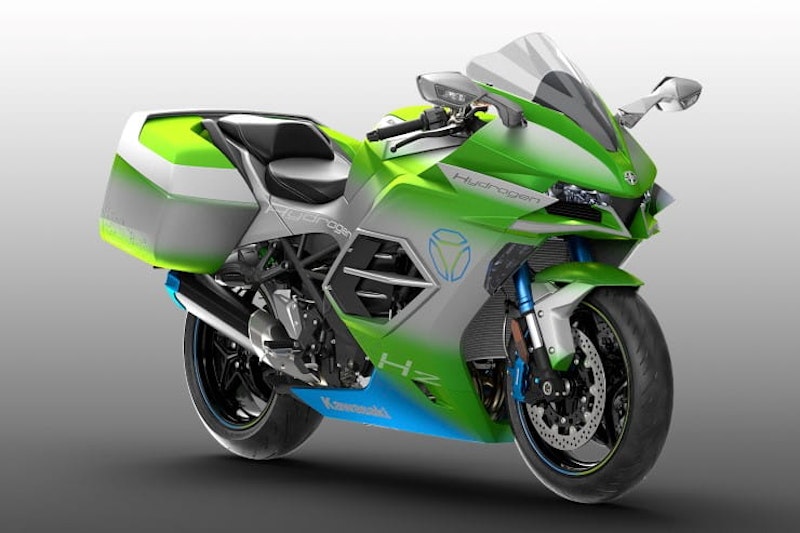Kawasaki hydrogen project gets named
By Ben Purvis
Motorcycle Journalist
10.03.2023
Kawasaki is going full steam ahead into its plans to develop bikes powered by hydrogen-fuelled combustion engines and having previewed such a model last year the project appears to have gained a name and logo.
New trademark applications from Kawasaki Motors – the company formed when Kawasaki Heavy Industries spun off its motorcycle business in 2021 – are aiming to get trademark rights on the name ‘HySE’ and a logo showing a water drop on two wheels. Both trademarks are intended specifically for ‘Non-electric prime movers for land vehicles, not including their parts; Hydrogen engines for land vehicles; Mechanical elements for land vehicles’ according to the applications. That word salad means the trademarks are aimed at combustion engines that burn hydrogen rather than fossil fuels.
Kawasaki showed its hydrogen concept last year
The environmental advantage of using hydrogen for combustion rather than petrol, diesel or any other fossil fuel is that while it burns energetically, it doesn’t emit any greenhouse gasses. In fact, the vast majority of the emissions from a hydrogen-fuelled engine are nothing more than water: hydrogen, when burnt, becomes H2O.
Although not entirely emissions-free, because the combustion process also creates some oxides of nitrogen – NOx – there’s no question that hydrogen combustion engines are vastly more environmentally-friendly than fossil-fuelled ones. Unlike battery-electric vehicles, hydrogen fuelled ones can also be refuelled comparatively quickly, and the hydrogen itself can be transported and stored in ways that electricity can’t. Several companies, including the likes of Toyota and JCB, are already committed to a hydrogen-based future, and Kawasaki – while favouring battery power for some new models – also believes it’s the way forward, particularly for larger, higher-performance bikes.
Supercharged H2 engine is being converted to hydrogen power
While Kawasaki’s motorcycle and engine business was spun off in 2021 to become Kawasaki Motors, the larger Kawasaki Heavy Industries is still its parent company and is also dedicated to the idea of a hydrogen-based economy in the future. The firm sees liquified hydrogen as the key to large volume transport, such as shipping, using hydrogen cooled to -253 degrees C. In doing so, hydrogen is shrunk to 1/800 of its ambient temperature volume, vastly improving its energy density. This sort of cryogenic storage is also the focus of Toyota’s plans for hydrogen vehicles, and Kawasaki and Toyota are working together on the project, along with Yamaha, Subaru and Mazda.
Unlike the carbon-neutral e-fuels that are being championed by some companies, including Ducati, hydrogen can’t be used as a simple ‘drop in’ replacement for petrol. Combustion engines must be specifically designed to run on hydrogen, and Kawasaki’s hydrogen-powered bike project uses the supercharged H2 four-cylinder as its basis. The fact Kawasaki already has a supercharged engine at its disposal is a useful leg up, since forced induction is all but essential on a hydrogen-fuelled combustion engine: naturally-aspirated hydrogen engines tend to be short on power. However, other tech also has to be added, most importantly direct fuel injection that fires the hydrogen straight into the combustion chamber after the intake valves have closed.
Hydrogen cannisters fill the panniers
Storage and refuelling are other hydrogen hurdles. Cooling the gas enough to turn it into a liquid requires energy and keeping it that cold while transporting it adds more difficulties. And while hydrogen is three times as energy-dense as petrol in terms of power-per-kilogramme, even in liquid form it’s very light – around a tenth of the weight of petrol for the same volume – so a litre of liquid hydrogen carries less energy than a litre of petrol.
Refuelling is tricky because of the low temperatures and high pressures involved in hydrogen storage. You can’t simply pour it into a tank like you do with petrol, so the solution Kawasaki is erring towards is the same as Toyota’s – using pre-filled cartridges of hydrogen that you swap for fresh ones when refuelling is needed.
Kawasaki’s hydrogen bike prototype features panniers filled with these cartridges, but the idea is broader than simply using them as fuel for bikes. Toyota, for instance, is currently building a prototype ‘city of the future’ – Woven City – at the foot of Mount Fuji, with portable hydrogen cannisters at the heart of its energy concept. The cartridges will be delivered to residents and can be used for a range of things, from powering vehicles to heating homes.
While it’s tempting to see hydrogen as an ‘alternative’ to electric power or synthetic e-fuels in the future, it’s probably wiser to see each as a different but equally valid route to carbon neutrality. In some situations battery-electric vehicles will make the most sense. In others, e-fuels will be the answer. And hydrogen-fuelled combustion engines also have the potential to carve out a niche for themselves. It’s not a question of ‘either/or’ but one of horses for courses.
Share on social media:

